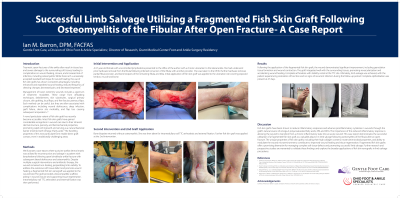Case Series/Study
(CS-022) Successful Limb Salvage Utilizing a Fragmented Fish Skin Graft Following Osteomyelitis of the Fibula After Open Fracture- A Case Report

Methods: We illustrate a case report where a piscine acellar dermal matrix was utilized for reconstruction and salvage in a patient with lymphedema following open bimalleolar ankle fracture with subsequent lateral dehiscence and osteomyelitis. Despite multiple surgical interventions and antibiotic therapy, the wound remained non-healing, jeopardizing limb viability. To address the extensive soft tissue defect and promote wound healing, a fragmented fish skin xenograft was applied to the wound bed. The graft provided a biocompatible scaffold, aiding in wound closure and supporting tissue regeneration. Intramedullary nail TTC arthrodesis and external fixation was then performed.
Results:
Following the application of the fragmented fish skin graft, the wound demonstrated significant improvement, including granulation tissue formation and wound contraction. The graft integrated well with the surrounding tissues, promoting revascularization and accelerating wound healing. Ultimately, limb salvage was achieved, with the patient experiencing restoration of function and no signs of recurrent infection during the follow-up period. Complete epithelization was present at 47 days.
Discussion:
Fish skin grafts have been shown to reduce inflammatory responses and advance proinflammatory cytokines in wounds through the graft’s natural source of omega-3 polyunsaturated fatty acids, EPA and DHA. The importance of this reduced inflammatory response is allowing the wound to transition from a chronic inflammatory state into an acute wound. This case report demonstrates the successful utilization of a fragmented fish skin graft as a valuable adjunct in limb salvage following osteomyelitis of the fibula after an open fracture. The unique properties of fish skin grafts, including their high collagen content, innate antimicrobial properties, and ability to modulate the wound microenvironment, contribute to improved wound healing and tissue regeneration. Fragmented fish skin grafts offer a promising alternative for managing complex soft tissue defects and promoting successful limb salvage. Further research and prospective studies are warranted to validate these findings and explore the broader applications of fish skin xenografts in limb salvage procedures.
Trademarked Items:
References:

.png)